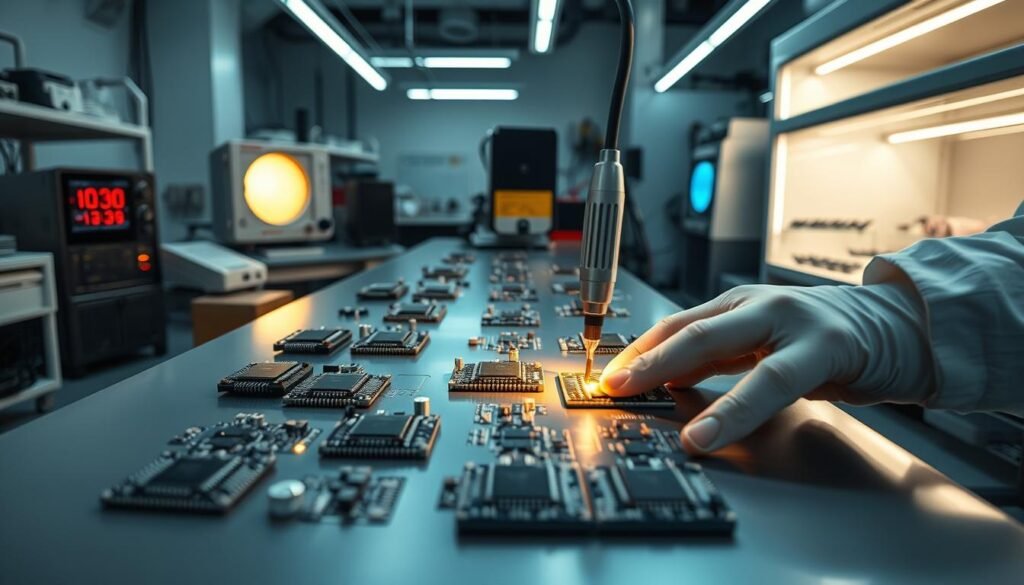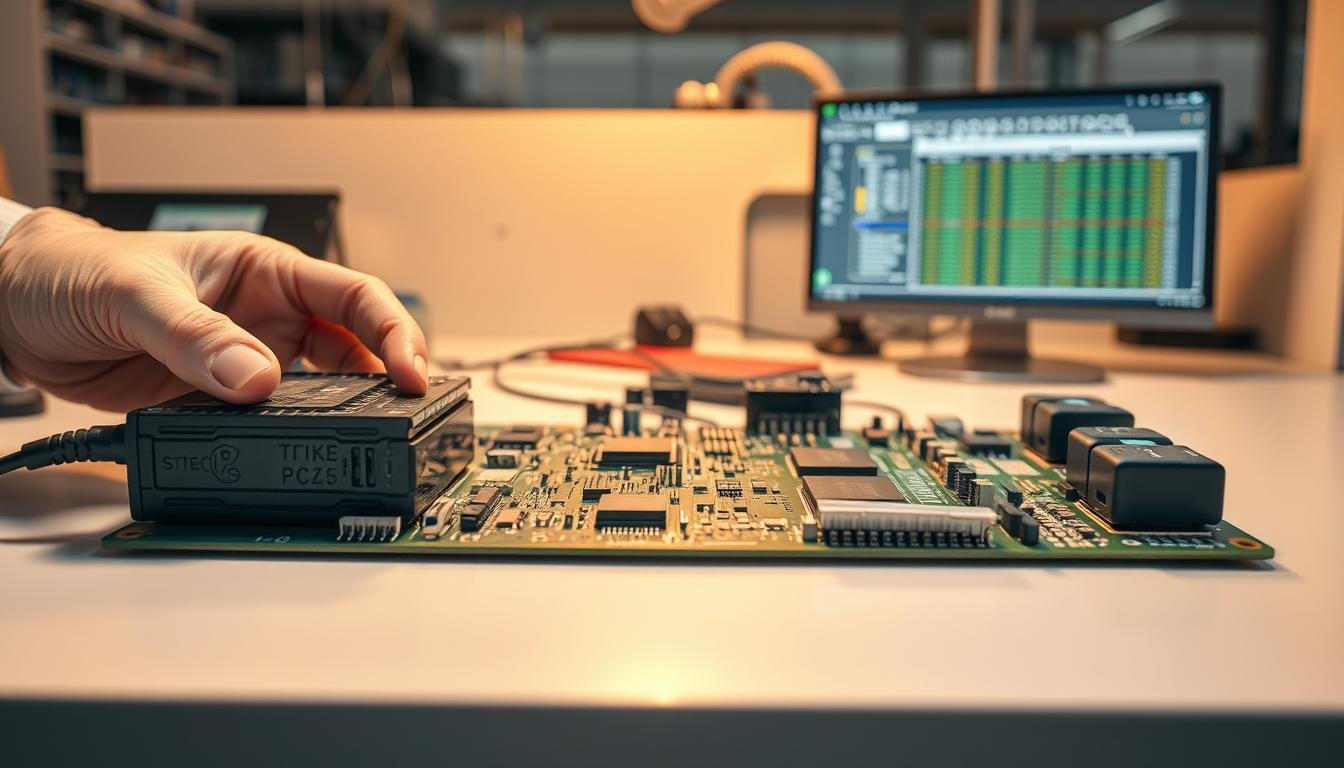What if the secret sauce powering modern electronics isn’t in the hardware or software—but in the invisible layer between them? This question lies at the heart of every device we use today. From smartphones to industrial machinery, firmware acts as the silent conductor orchestrating how components interact.
Firmware serves as foundational code embedded directly into non-volatile memory. Unlike traditional software, it’s designed to manage hardware operations at the most basic level. Without it, circuit boards remain inert collections of silicon and copper.
We’ve seen how flashing transforms blank PCBA units into functional systems. This step injects intelligence into devices, defining their behavior and capabilities. Manufacturers who master this process gain advantages in reliability, security, and performance.
Consider this: A single firmware error can brick an entire production batch. Yet flawless execution accelerates time-to-market while reducing costly revisions. That’s why precision here separates industry leaders from competitors.
Key Takeaways
- Firmware bridges hardware functionality with software-driven features
- Flashing processes determine device behavior from first boot
- Quality control during flashing impacts long-term product reliability
- Advanced techniques enable secure updates and feature upgrades
- Optimized workflows reduce manufacturing delays and costs
Introduction to Firmware Flashing in PCBA
Behind every responsive touchscreen and seamless device operation lies a critical step: firmware flashing. This process breathes life into circuit boards, converting raw components into smart systems that power our connected world.
Purpose and Importance
We design firmware flashing to achieve three core objectives:
- Activation: Wakes up hardware components during startup
- Control: Manages power flow and real-time operations
- Protection: Blocks malware through encrypted boot sequences
Without this step, devices remain inert. A smart thermostat would lack temperature logic. Medical equipment couldn’t monitor vital signs. Through precise code implantation, we transform generic chips into specialized controllers.
Overview of the PCBA Process
Modern electronics manufacturing follows two flashing approaches:
- Offline programming: Loading firmware onto chips before soldering
- In-system programming: Updating code after full assembly
We prioritize quality at both stages. Proper voltage regulation prevents corruption. Checksum verification ensures error-free installations. These steps separate reliable products from those prone to field failures.
Advanced security features now get embedded during flashing. Think of automotive systems rejecting unauthorized software or industrial robots detecting tampered code. These safeguards originate here, making firmware integration the cornerstone of trustworthy device design.
Understanding Firmware Flashing and Embedded Systems

At the core of every smart device lies a hidden conversation between silicon and instructions. Embedded systems execute this dialogue through precise coordination of hardware components and programmed logic. These specialized computing environments demand tailored approaches to code implementation.
Defining Firmware and Flashing Procedures
We design firmware as permanent software etched into non-volatile memory. The flashing process follows four critical phases:
- Code compilation for specific microcontroller architectures
- Verification through checksum validation
- Transfer via JTAG, SWD, or UART interfaces
- Post-flash functional testing
Modern IC programming techniques enable simultaneous updates across multiple devices. Memory constraints often dictate optimization strategies – 8-bit systems require leaner code than 64-bit counterparts.
How Embedded Systems Rely on Firmware
From coffee makers to MRI machines, these systems fall into three categories:
- Small-scale: 8/16-bit microcontrollers handling basic tasks
- Medium-scale: 32-bit processors managing sensor networks
- Complex: 64-bit units running real-time operating systems
Each class demands unique firmware architecture. A smart thermostat’s bootloader differs from an autonomous vehicle’s OS kernel. We prioritize layered designs that separate hardware control from application logic, ensuring adaptability across device generations.
The Role of Firmware Flashing in the PCBA Process

Every electronic device’s intelligence begins with a silent digital handshake between components and code. We implement firmware flashing to activate this communication, turning inert circuits into responsive systems that execute commands flawlessly.
| Stage | Method | Use Case |
|---|---|---|
| Pre-Assembly | Offline IC Programming | High-volume production runs |
| Post-Assembly | In-System Programming | Field updates & prototypes |
Microcontrollers and FPGAs demand different protocols than flash memory chips. We adapt our approach based on component specifications and production scales. For example, automotive ECUs require encrypted bootloaders during programming, while IoT sensors need calibration data injection.
Three critical functions emerge during this phase:
- Functional activation: Verifies power delivery and signal integrity
- Performance tuning: Sets clock speeds and I/O configurations
- Security layering: Embeds authentication keys and tamper alerts
Our testing protocols cross-check every programmed IC against golden samples. This catches soldering defects and component mismatches that visual inspections miss. A medical device manufacturer reduced field failures by 38% after implementing our multi-stage verification process.
Final quality benchmarks get established here. We measure boot success rates, memory allocation efficiency, and error correction responsiveness. These metrics determine whether boards advance to enclosure assembly or require rework.
Firmware Flashing Process Workflow in PCB Assembly
How do raw circuit boards evolve into intelligent systems? The answer lies in a meticulously structured development path. We implement nine-phase workflows to transform concept into reliable code execution.
Step-by-Step Development and Integration
Our methodology begins with requirements analysis – defining functionality, safety thresholds, and performance benchmarks. Architecture design follows, mapping memory allocation and API structures. This blueprint guides code implementation in optimized languages like C++ or Rust.
Three core phases drive success:
- Precision coding: Adherence to MISRA-C standards ensures error-resistant logic
- Modular assembly: Incremental integration reduces system-wide failures
- Hardware calibration: Adjusting timing parameters for real-world conditions
Testing and Verification Methods
Validation occurs at multiple checkpoints. Unit tests scrutinize individual functions using simulated data inputs. Integration trials assess module interactions through automated scripts. Final system testing replicates operational environments with live hardware.
We employ:
- Boundary value analysis for stress testing
- Regression suites to safeguard against update-induced errors
- Cyclomatic complexity metrics to evaluate code maintainability
“Thorough documentation turns development insights into institutional knowledge.”
Post-validation, boards receive encrypted firmware packages. Version-controlled builds enable traceability from prototype to mass production. This approach slashes debugging time by 42% in field deployments.
Best Practices for Reliable Firmware Updates
Reliable firmware updates separate functional devices from mission-critical systems. We prioritize three pillars: security, integrity, and adaptability. These principles guide every code revision, whether deploying over-the-air patches or factory-installed builds.
Our methodology starts with modular architecture. Discrete components with clear interfaces allow targeted updates without system-wide disruptions. Hardware abstraction layers prevent dependency locks, enabling seamless transitions between chipset generations.
- Input validation gates filter all external data streams
- Static analysis tools flag memory leaks during compilation
- Watchdog timers reboot unresponsive subsystems automatically
For best practices in firmware management, we enforce strict complexity limits. Single-responsibility modules reduce error cascades by 63% compared to monolithic codebases. Dynamic runtime analysis identifies bottlenecks before field deployments.
Security protocols get baked into update mechanisms. Encrypted checksums verify package authenticity, while fail-safe defaults restore stable configurations during interrupted installations. Rugged designs withstand voltage fluctuations and memory overflows common in industrial environments.
Autonomous validation systems provide real-time health monitoring. Assertion checks compare actual outputs against predicted ranges, triggering alerts for deviations. This layered approach ensures update integrity across the device lifecycle – from initial flashing to end-user modifications.
Essential Tools and Techniques for Firmware Flashing
Building intelligent devices requires a specialized toolkit – think of it as a surgeon’s precision instruments for electronic systems. We assemble robust development environments combining cutting-edge software and hardware interfaces to handle code implementation and validation.
Programming Tools and Debugging Interfaces
Our toolchain begins with integrated development environments like Eclipse Embedded CDT. These platforms merge code editing, compilation, and real-time debugging into unified workspaces. Cross-compilers such as GNU Arm translate high-level instructions into machine code optimized for specific microcontrollers.
Three critical components drive success:
- Hardware debuggers: JTAG interfaces enable stepped execution and memory inspection
- Emulation software: QEMU simulates target hardware during early development phases
- Automation systems: Makefiles standardize build processes across teams
| Tool Type | Example | Key Benefit |
|---|---|---|
| Static Analysis | Coverity | Identifies security flaws pre-deployment |
| Version Control | Git | Enables collaborative code management |
| Testing Framework | xUnit | Automates regression checks |
“Proper debugging access cuts problem-solving time by 60% in complex embedded systems.”
We implement layered validation using profilers like Valgrind to optimize memory usage. Documentation generators such as Doxygen maintain clear technical records, while bug trackers streamline issue resolution. This comprehensive approach ensures firmware behaves predictably across all operational scenarios.
Addressing Challenges and Debugging Firmware Issues
Navigating firmware complexities requires more than technical skill—it demands strategic problem-solving. We balance resource constraints with operational demands, ensuring devices perform reliably under real-world conditions.
Troubleshooting Common Flashing Errors
Memory allocation failures and power inconsistencies top the list of flashing challenges. We combat these through checksum validation and automated debugging tools that pinpoint timing conflicts. Voltage fluctuations during programming often cause silent corruption—our protocols detect these anomalies before code finalization.
Concurrency issues emerge when multiple processes compete for limited resources. We implement prioritized task scheduling and atomic operation safeguards. This prevents race conditions while maintaining system responsiveness across parallel operations.
Optimizing Performance for Constrained Resources
Memory optimization starts with byte-level efficiency. We select compact data types and streamline algorithms to maximize functionality within 8KB-32KB microcontrollers. Execution paths get refined through static analysis tools that eliminate redundant operations.
Power management tactics include dynamic frequency scaling and sleep mode triggers. These adjustments reduce energy consumption by 40% in IoT devices without sacrificing performance. Our layered debugging approach combines LED status indicators with selective UART logging for resource-limited environments.
Cross-platform compatibility challenges get solved through hardware abstraction layers. Conditional compilation allows single-codebase support for multiple device variants. This strategy cuts maintenance costs while ensuring decade-long lifecycle support for industrial systems.
FAQ
Why is firmware flashing critical during PCBA manufacturing?
What tools are commonly used for programming microcontrollers in PCBA?
How do we maintain firmware integrity during mass production?
What challenges arise when updating firmware on deployed devices?
How does flash memory type affect firmware development?
What role does debugging play in firmware flashing processes?
Can power interruptions during flashing damage PCBA components?
About The Author
Elena Tang
Hi, I’m Elena Tang, founder of ESPCBA. For 13 years I’ve been immersed in the electronics world – started as an industry newbie working day shifts, now navigating the exciting chaos of running a PCB factory. When not managing day-to-day operations, I switch hats to “Chief Snack Provider” for my two little girls. Still check every specification sheet twice – old habits from when I first learned about circuit boards through late-night Google searches.
